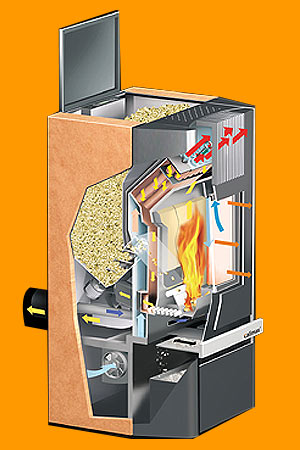pellet stove maintenance

If you've just installed a pellet stove it's important to get into a regular habit of cleaning and upkeeping it to get the best out of the appliance. The maker's instructions will give you specifics of what to do. Below are a few general tips and areas to watch out for.
Burn pot
Check the burn pot every day and clean it periodically to keep the air inlets open. How often you need to clean the burn pot depends on the type and grade of fuel you're using. Check your manual for details.
The burn pot is the stove's carburetor, mixing the air and the fuel to enable combustion. As in a car, the correct adjustment of the air and fuel rates is crucial to getting top performance. When your stove is running normally you should see a bright yellow or white flame. You may also notice a white or gray build up of ash on the glass on high burn and a darker fluffy ash on low burn: this is normal. But if the flame is orange and sooty or there's a build up of a brown caramel-like substance, then you need to take some action because your stove isn't burning efficiently.
Some stoves are equipped with air dampers or adjustable feed openings that you can adjust yourself. Other models stoves will require adjustment to the control board which may require a qualified technician.
Another problem to watch out for is a buildup of clinkers in the firebox. Clinkers are formed from ash that has melted and then hardened. If ash in the burn pot starts to melt, as it can easily do at the high temperatures reached in modern stoves, then it can block the air holes of the incoming air and upset the mixture of air and fuel. Incorrect adjustment of the air to fuel ratio can greatly increase the likelihood of clinker formation. This is due to the stoves inability to adequately burn the excess fuel and remove the excess ash that is building up in the burn pot. Clinkers are easily removed, even while the stove is in operation, by using the ash tool or rake that comes with your pellet stove.
Ash drawer
Empty the ash drawer before starting a new fire and occasionally by interrupting stove operation. How you need to empty the ash drawer during operation of the stove depends on the type of fuel and the stove design. Typically this will be once or twice a week, but may be monthly in some new designs.
Heat exchanger
Also located in the combustion chamber is the heat exchanger which is designed to transfer the heat being produced by the burning fuel in the burn pot into clean hot air for distribution into the home. This is usually done by a chamber or a series of tubes located in the firebox that the hot air and gases pass over, heating the outside of the chamber before exiting the stove. Fresh air is passed through the inside of the chamber drawing the heat out of the stove and into the room. For maximum efficiency the surface of the heat exchanger should be cleaned regularly. The frequency of these cleanings will depend on your stove design and may range from daily to monthly. Refer to your owner's manual for cleaning instructions. On some stoves, cleaning is simply a matter of moving a rod that scrapes the tubes inside the stove. Other stoves, however, may require professional service.
Ash traps
These are chambers located behind the fire chamber which prevent excess fly ash in the exhaust from exiting the stove. In some designs they are easily accessed for ash removal by owners. Other designs require professional service.
Glass
Clean with glass cleaner when the glass is completely cool on stoves with effective air wash systems. May require more vigorous methods on others.
Hopper and auger
Check for accumulated sawdust materials (fines). The fuel in the hopper and auger tube should be run out occasionally to prevent auger blockage by fines.
Cleaning the venting system and other difficult components
Most owners have the venting systems of their stoves cleaned by professionals. However, you may want to tackle it yourself if you're handy, thoroughly knowledgeable, and have the right equipment.
If the vent pipe becomes blocked some smoke may leak into your home. Most pellet burning appliances have a safety switch that will interrupt their operation and keep any exposure to a minimum.
Motors and fans need occasional cleaning and may need lubricating. Using the wrong lubricant or wrong amount of lubricant, however, can damage components. Some components that have to be removed for service need gaskets to be replaced. Gaskets for the fire chamber door, ash pan door, and hopper lid (on some designs) may need replacing occasionally to keep the seals tight.
Troubleshooting
If you notice dirty or sooty burning in the combustion chamber, here are some possible remedies:
Professional cleaning and maintenance
Most pellet stove owners use professional service for cleaning and preventive maintenance on at least an annual basis. Many dealers offer service plans that offer reduced costs and convenient scheduling. Cleaning and maintenance services usually performed include:
Finding competent in-home service should really be part of the buying decision, since service is needed at least on an annual basis. Many stove shops and service technicians offer a service plan that specifies a service schedule, what is covered, travel costs, and other details.
